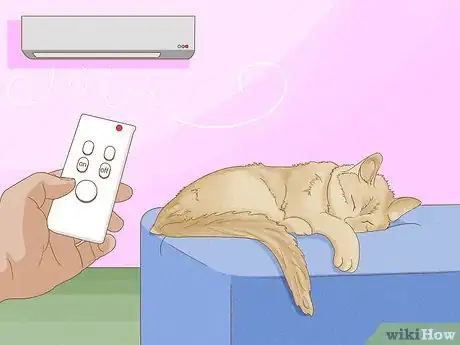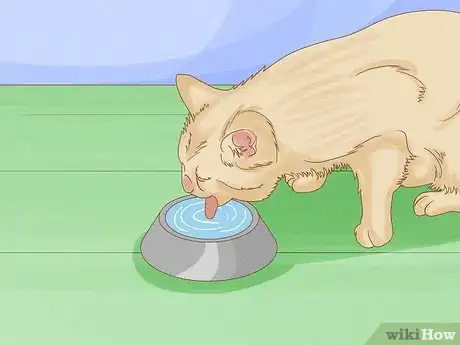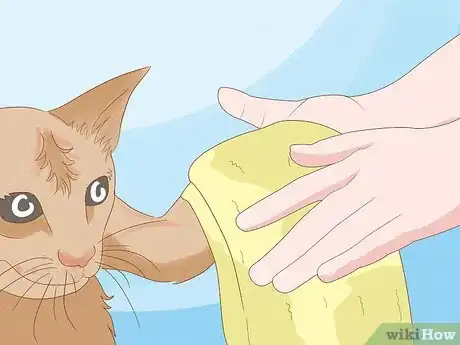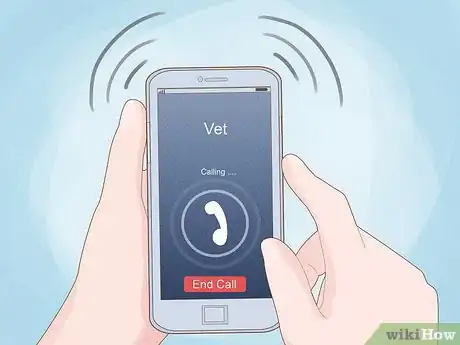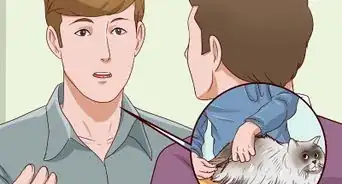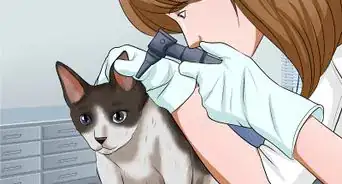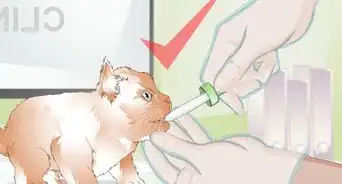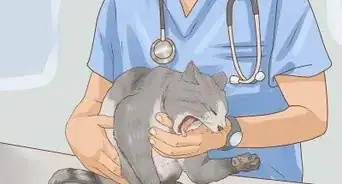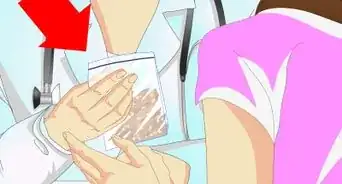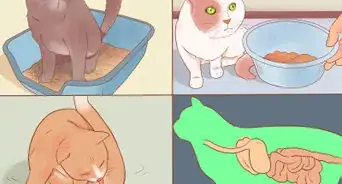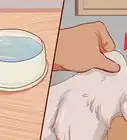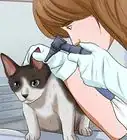This article was co-authored by Pippa Elliott, MRCVS. Dr. Elliott, BVMS, MRCVS is a veterinarian with over 30 years of experience in veterinary surgery and companion animal practice. She graduated from the University of Glasgow in 1987 with a degree in veterinary medicine and surgery. She has worked at the same animal clinic in her hometown for over 20 years.
wikiHow marks an article as reader-approved once it receives enough positive feedback. This article received 24 testimonials and 100% of readers who voted found it helpful, earning it our reader-approved status.
This article has been viewed 637,228 times.
A cat that becomes overheated in summer can suffer from dehydration, heatstroke, and shock. Unlike people, cats don't sweat and therefore it can be a struggle for them to keep cool when summer temperatures start to climb. A cat's main methods of cooling off include staying out of the sun, being inactive, drinking water, and panting. None of these methods are too effective and a cat that is stuck in a roasting house or car without a means of escape will become overheated and at risk of heat stroke.[1] But there are several things that you can do to help your cat cool down in the summer so that he or she will be healthy and happy.
Steps
Providing a Cool Environment for Your Cat
-
1Run the air conditioning. If you have air conditioning, keeping your cat indoors will ensure that he stays cool too. Many of the things you do to keep the house cool for yourself will also benefit your cat, such as keeping the blinds, drapes, and doors closed.
- Make sure that your cat can go into a warmer room if she feels too cold. (Sometimes air-conditioning and fans can make things too cold and this may be irritating for a cat, after a while.)
- Even if your cat likes to spend time outside, it is recommended to keep your cat inside during the hottest part of summer days, which is between 11am and 6pm.
-
2Use fans to improve the air flow in your home. If you do not have air condition, fans and open windows are another good option to cool off your home and your cat. Place fans in front of open windows to move air through your home and cool it down. Make sure the fans you use are safe for your pet to be around by checking to see if the cover for the rotating blades is secure.
- Place one fan or more at floor level in a corner of the room facing towards the center of the room. This way the cat can lay at a distance that is comfortable for her to get some air movement over her fur. This air movement helps to cool down your cat in a way that is similar to sweating.[2]
Advertisement -
3Provide fresh drinking water at all times. Cats need access to water in order to stay hydrated. In addition, when your cat’s blood temperature rises, sensors in the brain tell her to drink water in order to cool down and dilute the blood. Therefore, it is essential to make sure that your cat always has access to clean, fresh water.
- Provide multiple drinking bowls with a large surface area (such as dinner plates or dog bowls). Wider bowls encourage the cat to drink because cat do not like their whiskers to touch the sides of the bowl. Make sure that you replace the water at least once a day and keep it topped up at all times.
- Never let your cat drink from water than contains algae as the latter is toxic and may cause diarrhea, vomiting, seizures, and sudden death.[3]
- Consider getting a cat drinking fountain. Many cats prefer to drink running water and a cat drinking fountain is a great way to do this.
-
4Let your cat choose a cool spot. Cats are smart about comfort at all times, including during the heat. Cats love to curl up in the bathtub or sink because porcelain stays cool even when it is hot outside. Because they are often cooler, cats sometimes prefer tiled areas of the house, such as the bathroom, laundry room, and kitchen. If your cat chooses a spot and seems comfortable, let her be.[4]
Helping Your Cat Cool Down
-
1Allow your cat to be sedentary on hot days. Now is not the time to play energetic games with the cat. Chasing after a laser pointer or a wing-on-a-string is definitely out. Instead, encourage the cat to rest and take it easy. Muscular activity generates heat, which the cat doesn't not need on top of the already hot conditions.[5]
-
2Make sure that your cat has access to shade. Take sensible precautions such as ensuring the cat has access to shade when outside, and does not have to stay in the full sun. This could be the shade form a tree or bush, or a garden umbrella. If your cat is indoors, make sure that she is not restricted to a room with lots of bright sunlight and that she can rest out of the glare of the sunshine.[6]
- If you have an outdoor cat, make sure that you check any outdoor buildings and greenhouses before closing the doors. The building could become very hot and your cat could die as a result if he or she were to be locked inside.
-
3Cool down your cat with damp towels. Most cats do not like getting wet, but you can at help them to cool off a little with dampened towels. Simply dampen a cloth with cool water and gently stroke your cat with the cloth or towel from the top of its head and down the back.
- If the cat is very hot, gently wipe her with a wet towel as often as she will tolerate.
-
4Brush your cat daily. Matted fur traps heat; ensuring that the fur is not matted and allows air to flow through it will help to keep your cat cool. This is especially important for long-haired breeds of cats.
- Get into the routine of combing and brushing your cat during the coolest part of the day before she gets hot, such as first thing in the morning. She will be more willing to cooperate if she isn't already feeling cranky because of the heat.
- Avoid shaving your cat to the skin as this will expose your cat to the sun and can result in sunburn and risks skin cancer.
- Although it seems bizarre to wear a thick fur coat on a hot day, experts now believe the fur keeps heat out in the summer, as well as in during the winter. Thus shaving the coat may not help kitty to stay cool.
- However, if the coat is severely matted or tangled, it forms a shell over the cat's body. This shell means the coat doesn't work how it is meant to and so getting a professional to shave the coat is the best idea
-
5Create a cool retreat. You can help your cat cool down by making a cool, dark spot for her to retreat to when she gets too hot. Just place a cardboard box on its side and put it somewhere that is quiet and out of the way, such as in a closet, behind a chair, or near a cool spot in the house. Line it with a terry towel or other cool cotton fabric. Stick an ice pack inside a sock and place it into the retreat underneath the towel for an added cooling effect.[7]
- Another good idea is to place towels or sheets over your cat's favorite spots. Doing so will create a cool barrier between your cat’s fur and warmer surfaces.
Identifying and Treating Heatstroke
-
1Watch for signs of heatstroke. Signs of heatstroke include excessive panting and rapid breathing, lethargy, bright pink ears, confusion, weakness and inability to stand, shaking, tremors, and possibly even seizures.[8]
- A cat with heatstroke will also feel hot to the touch on the pads of her feet. If you suspect that your cat is suffering from heatstroke, place your cat on a cool surface right away, such as a tiled floor. Then turn on a fan and place it so that it is blowing on her to remove some of the heat.
-
2Cool your cat down with cool damp washcloths and provide water. If your cat appears to be suffering from heatstroke, place cool damp washcloths over her paws and offer her some water to drink right away. If she is too weak to drink the water, try to moisten her gums with water using a damp cloth.
- Avoid ice water or very cold water as the temperature difference between the extreme heat and extreme cold can send the cat into a form of shock.
-
3Call your cat’s veterinarian for advice. Your cat may need to be taken to see your veterinarian to treat her heatstroke. A veterinarian can provide intravenous fluids to reduce your cat’s core temperature and maintain the blood supply to her organs. As your cat’s temperature rises, her blood will become thicker and circulation to vital organs can be impaired.[9]
- Call your cat’s veterinarian right away if you suspect that your cat is suffering from heatstroke.
Expert Q&A
Did you know you can get expert answers for this article?
Unlock expert answers by supporting wikiHow
-
QuestionWhat temperature can a cat tolerate?
 Pippa Elliott, MRCVSDr. Elliott, BVMS, MRCVS is a veterinarian with over 30 years of experience in veterinary surgery and companion animal practice. She graduated from the University of Glasgow in 1987 with a degree in veterinary medicine and surgery. She has worked at the same animal clinic in her hometown for over 20 years.
Pippa Elliott, MRCVSDr. Elliott, BVMS, MRCVS is a veterinarian with over 30 years of experience in veterinary surgery and companion animal practice. She graduated from the University of Glasgow in 1987 with a degree in veterinary medicine and surgery. She has worked at the same animal clinic in her hometown for over 20 years.
Veterinarian
-
QuestionCan cats keep themselves warm?
 Pippa Elliott, MRCVSDr. Elliott, BVMS, MRCVS is a veterinarian with over 30 years of experience in veterinary surgery and companion animal practice. She graduated from the University of Glasgow in 1987 with a degree in veterinary medicine and surgery. She has worked at the same animal clinic in her hometown for over 20 years.
Pippa Elliott, MRCVSDr. Elliott, BVMS, MRCVS is a veterinarian with over 30 years of experience in veterinary surgery and companion animal practice. She graduated from the University of Glasgow in 1987 with a degree in veterinary medicine and surgery. She has worked at the same animal clinic in her hometown for over 20 years.
Veterinarian
-
QuestionCan a cat get overheated?
 Pippa Elliott, MRCVSDr. Elliott, BVMS, MRCVS is a veterinarian with over 30 years of experience in veterinary surgery and companion animal practice. She graduated from the University of Glasgow in 1987 with a degree in veterinary medicine and surgery. She has worked at the same animal clinic in her hometown for over 20 years.
Pippa Elliott, MRCVSDr. Elliott, BVMS, MRCVS is a veterinarian with over 30 years of experience in veterinary surgery and companion animal practice. She graduated from the University of Glasgow in 1987 with a degree in veterinary medicine and surgery. She has worked at the same animal clinic in her hometown for over 20 years.
Veterinarian
Warnings
- The most common cause of heatstroke is being left in a hot, poorly ventilated area, usually a car or a hot room. Do not leave a cat in a car during the heat of summer without ventilation and in the baking sun, and never leave a cat in a car, unattended.⧼thumbs_response⧽
References
- ↑ Nelson, R, and Couto, G, (2013), Small Animal Internal Medicine, ISBN 978-0323086820
- ↑ http://www.catster.com/the-scoop/10-ways-to-help-your-cat-beat-the-summer-heat
- ↑ Nelson, R, and Couto, G, (2013), Small Animal Internal Medicine, ISBN 978-0323086820
- ↑ http://www.petmd.com/dog/slideshows/care/7-tips-keep-your-pet-cool-summer
- ↑ http://www.catster.com/the-scoop/10-ways-to-help-your-cat-beat-the-summer-heat
- ↑ http://www.petmd.com/dog/slideshows/care/7-tips-keep-your-pet-cool-summer
- ↑ Frazier, A, (2008), The Natural Cat , ISBN 978-0-452-28975-8
- ↑ Nelson, R, and Couto, G, (2013), Small Animal Internal Medicine, ISBN 978-0323086820
- ↑ Nelson, R, and Couto, G, (2013), Small Animal Internal Medicine, ISBN 978-0323086820
About This Article
To cool your cat down in the summer, keep the air conditioner running during the day and use extra fans to improve air circulation in your home. Try to keep drapes and blinds closed to block out the sun's rays and minimize temperature fluctuations, and keep multiple water dishes available at all times. Brushing your kitty every day can prevent matted fur, which traps unnecessary heat near their bodies. For tips on recognizing and treating heat stroke in cats, read on!
